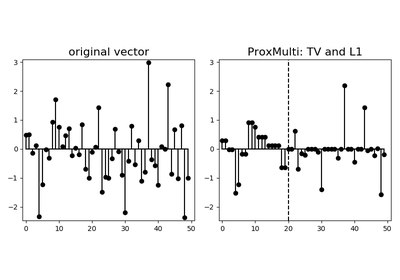tick.prox.ProxMulti¶
-
class
tick.prox.ProxMulti(proxs: tuple)[source]¶ Multiple proximal operator. This allows to apply sequentially a list of proximal operators. This is convenient when one wants to apply different proximal operators on different parts of a vector.
- Parameters
proxs :
tupleofProxA tuple of prox operators to be applied successively.
- Attributes
dtype :
{'float64', 'float32'}Type of the arrays used.
-
call(coeffs, step=1.0, out=None)¶ Apply proximal operator on a vector. It computes:
\[argmin_x \big( f(x) + \frac{1}{2} \|x - v\|_2^2 \big)\]- Parameters
coeffs :
numpy.ndarray, shape=(n_coeffs,)Input vector on which is applied the proximal operator
step :
floatornp.array, default=1.The amount of penalization is multiplied by this amount
If
float, the amount of penalization is multiplied by this amountIf
np.array, then each coordinate of coeffs (within the given range), receives an amount of penalization multiplied by t (available only for separable prox)
out :
numpy.ndarray, shape=(n_params,), default=NoneIf not
None, the output is stored in the givenout. Otherwise, a new vector is created.- Returns
output :
numpy.ndarray, shape=(n_coeffs,)Same object as out
Notes
stepmust have the same size ascoeffswhenever range isNone, or a size matching the one given by the range otherwise
-
value(coeffs: numpy.ndarray)[source]¶ Returns the value of the penalization at
coeffs. This returns the sum of the values of each prox called on the same coeffs.- Parameters
coeffs :
numpy.ndarray, shape=(n_coeffs,)The value of the penalization is computed at this point
- Returns
output :
floatValue of the penalization at
coeffs
